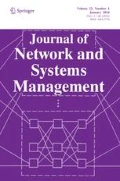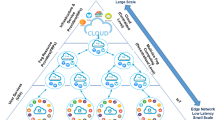Abstract
Hybrid CDN–P2P networks (HCDNs) combine Peer to Peer (P2P) networks and Content Delivery Networks (CDN) to benefit from their complementary advantages. In order to enable a traditional CDN to offer hybrid content delivery service, we introduce a resource scheduling mechanism to perform the request routing process and determine the desired level of contribution for users. The proposed mechanism relies on a truthful, profit maximizing, envy-free auction to optimize contributions of the end-users in P2P content delivery. Based on the proposed solution, economics of content delivery in the HCDN are studied and it is shown that through our resource scheduling mechanism, it is possible to serve a big fraction of end-users with higher quality content, increase the net profit of the HCDN provider, and decrease expenditures of the content provider simultaneously.














Similar content being viewed by others
Notes
The situation in which peers are consuming resources without fair contribution of their resources.
The situation in which no customer has an incentive to dispute the allocation. In the economics literature, the notion of envy-freeness was used to model fair equilibrium pricing in various settings.
Independent and Identically Distributed.
Nash equilibrium: a situation in which economic actors interacting with one another, each choose their best strategy given the strategies that all the other actors have chosen.
References
Yin, H., Liu, X., Zhan, T., Sekar, V., Qiu, F., Lin, C., Zhang, H., Li, B.: Design and deployment of a hybrid CDN–P2P system for live video streaming: experiences with LiveSky. In: 17th ACM International Conference on Multimedia, pp. 25–34 (2009)
Pathan, M., Buyya R.: A taxonomy of CDNs. In: Content Delivery Networks, Ch. 2, pp. 33–77. Springer, Berlin (2008)
Pallis, G., Vakali, A.: Insight and perspectives for content delivery networks. Commun. ACM 49(1), 101–106 (2006)
Buyya, R., Pathan, M., Vakali, A.: Content Delivery Networks. Springer, Berlin (2008)
Cardellini, V., Colajann, M., Yu, P.S.: DNS dispatching algorithms with state estimators for scalable Web-server clusters. World Wide Web 2(3), 101–113 (1999)
Weihong W., Li B.: Market-driven bandwidth allocation in selfish overlay networks. In: INFOCOM 2005. 24th Annual Joint Conference of the IEEE Computer and Communications Societies, pp. 2578–2589 (2005)
Michal, F., Chuang, J.: Overcoming free-riding behavior in peer-to-peer systems. ACM SIGecom Exch. 5(4), 41–50 (2005)
Ramayya, K., Smith, M.D., Tang, Z., Telang, R.: The impact of free-riding on peer-to-peer networks. In: IEEE 37th Annual Hawaii International Conference on in System Sciences, Hawaii, pp. 1–10 (2004)
Shen, X., Heather, Y., Buford, J., Mursali, A.: Handbook of peer-to-peer networking. Springer, Heidelberg (2010)
Garmehi, M., Analoui, M., Pathan, M., Buyya, R.: An economic mechanism for request routing and resource allocation in hybrid CDN–P2P networks. Int. J. Network Manage. (2015). doi:10.1002/nem.1891
Huang, C., Wang, A., Li, J., Ross, K.W.: Analysis of a CDN–P2P hybrid architecture for cost-effective streaming media distribution. Multimed. Syst. 11(4), 383–399 (2006)
Ha, I., Wildman, S.S., Bauer, J.M.: P2P, CDNs, and hybrid networks: the economics of Internet video Distribution. Int. Telecommun. Policy Rev. 17(4), 1–22 (2010)
Hai, J., Li, J., Li Z., Bai X.: Performance evaluation of content distribution in hybrid CDN–P2P network. In: IEEE Future Generation Communication and Networking, FGCN08, pp. 188–193 (2008)
ZhiHui, L., Wang, Y., Yang, R.Y.: An analysis and comparison of CDN–P2P hybrid content delivery system and model. J. Commun. 7(3), 232–245 (2012)
Lu, Z.H., Gao, X.H., Huang, S.J., Huan, Yi.: Scalable and reliable live streaming service through coordinating CDN and P2P. In: IEEE 17th International Conference on Parallel and Distributed Systems (ICPADS), pp. 581–588 (2011)
Bogdan, F., Andreica, M.I.: Towards a peer-assisted content delivery architecture. In: 18th International Conference on Control Systems and Computer Science (CSCS), pp. 521–528 (2011)
Bronzino, F., Gaeta, R., Grangetto, M., Pau, G.: An adaptive hybrid CDN/P2P solution for content delivery networks. In: IEEE Visual Communications and Image Processing (VCIP), pp. 1–6 (2012)
Chao, H., Chen, M., Xing, C., Bo, X.: EUE principle of resource scheduling for live streaming systems underlying CDN–P2P hybrid architecture. Peer-to-Peer Netw. Appl. 5(4), 312–322 (2012)
Yin, H., Liu, X., Zhan, T., Sekar, V., Qiu, F., Lin, C., Zhang, H., Li, B.: Livesky: enhancing CDN with P2P. ACM Trans. Multimed. Comput. Commun. Appl. TOMCCAP 6(3), 1–16 (2010)
Khalaji, F.K., Analoui, M.: Replica placement algorithms in hybrid CDN–P2P architectures. In: IEEE Sixth International Conference on Telecommunications, pp. 771–775 (2012)
Wang Z., Jiang, H., Sun, Y., Li, J., Liu, J., Dutkiewicz, E.: A K-coordianted decentralized replica placement algorithm for the ring-based CDN–P2P architecture. In: IEEE Symposium on/Computers and/Communications, pp. 811–816 (2010)
Buford, J., Heather, Yu., Lua, K.: P2P Networking and Applications. Morgan Kaufmann, San Francisco (2009)
Garmehi, M., Analoui, M.: A distributed mechanism for economic management of transmission infrastructure in hybrid CDN–P2P networks. Econ. Comput. Econ. Cybern. Stud. Res. ECECSR 3, 278–307 (2014)
Myerson, R.B.: Optimal auction design. Math. Oper. Res. 6(1), 58–73 (1981)
Manzato, D.A.G., da Fonseca, N.L.S.: Incentive mechanisms for cooperation peer-to-peer networks. In: Handbook of Peer-to-Peer Networking, pp. 631–660. Springer, Heidelberg (2010)
Yi, C., Xue, Y., Nahrstedt, K.: Optimal resource allocation in overlay multicast. IEEE Trans. Parallel Distrib. Syst. 17(8), 808–823 (2006)
Xiao, S., Dhaliwal, S.K.: Incentive mechanisms in P2P media streaming systems. IEEE Internet Comput. 14(5), 74–81 (2010)
Noam, N., Roughgarden, T., Tardos, E.: Algorithmic game theory. Cambridge University Press, Cambridge (2007)
Oksana, L., Haibin, L., Wang, H.X.: Incentive schemes in peer-to-peer networks. BE J. Theor. Econ. 9(1), 1–20 (2009)
Rothkopf, M.H.: Thirteen reasons why the Vickrey–Clarke–Groves process is not practical. Oper. Res. 77(2), 191–197 (2007)
Chuan, W., Li, Z., Qiu, X., Lau, F.: Auction-based P2P VoD streaming: incentives and optimal scheduling. ACM Trans. Multimed. Comput. Commun. Appl. 8(1), 1400–1422 (2012)
Yang, G., Chen, Y., Liu, K.J.: A cheat-proof game-theoretic framework for cooperative peer-to-peer video streaming. In: IEEE International Conference on Acoustics, Speech and Signal Processing (ICASSP), pp. 2297–2300 (2012)
Hurvics, L., Reiter, S.: Designing Economic Mechanisms. Cambridge University Press, Cambridge (2006)
Goldberg, A.V., Hartline, J.D., Karlin, A.R., Saks, M., Wright, A.: Competitive auctions. Games Econ. Behav. 55, 242–269 (2006)
Hartline, J.D., Roughgarden, T.: Simple versus optimal mechanisms. In: 10th ACM Conference on Electronic Commerce, pp. 225–234 (2009)
Garmehi, M., Analoui, M., Pathan, M., Buyya, R.: An economic replica placement mechanism for streaming content distribution in Hybrid CDN–P2P networks. Comput. Commun. COMCOM 52, 60–70 (2014)
Mankiw, N.G.: Principles of Microeconomics. South-Western Publishing, Mason (2011)
Kartik, H., Krishnan, R., Chuang, J., Choudhary, V.: Pricing and resource allocation in caching services with multiple levels of quality of service. Manage. Sci. 51(12), 1844–1859 (2005)
Hartline, J.D., McGrew, R.: From optimal limited to unlimited supply auctions. In: The 6th ACM Conference on Electronic Commerce, pp. 175–182 (2005)
Author information
Authors and Affiliations
Corresponding author
Appendix
Appendix
Pseudo code 1. Implementation of HRA in an end-user’s machine.
Pseudo code 2. Implementation of HRA process in an HRAS server.
Pseudo code 3. Implementation of HRA process in an edge server.
Rights and permissions
About this article
Cite this article
Garmehi, M., Analoui, M. Envy-Free Resource Allocation and Request Routing in Hybrid CDN–P2P Networks. J Netw Syst Manage 24, 884–915 (2016). https://doi.org/10.1007/s10922-015-9359-3
Received:
Revised:
Accepted:
Published:
Issue Date:
DOI: https://doi.org/10.1007/s10922-015-9359-3




